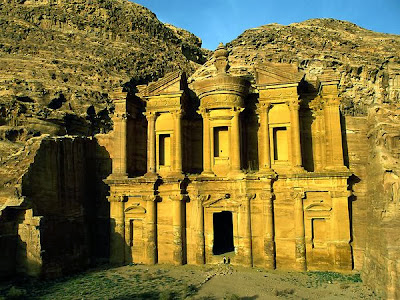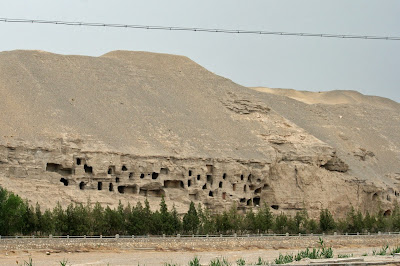Early peoples relied upon the natural environment to give them shelter. Hunters made camps beneath cliffs, and families often lived and sheltered in natural caves.
Ad Deir ("The Monastery") is a monumental building carved out of rock in the ancient Jordanian city of Petra. Built by the Nabataeans in the 1st century and measuring 50 meters wide by approximately 45 meters high, architecturally the Monastery is an example of the Nabatean Classical style. It is the second most visited building in Petra after Al Khazneh. The Monastery is beautifully carved, though much less decorated than the Treasury, and so huge that even the doorway is several stories tall. Its name, like most Petra structures, does not reflect reality: it was probably a Nabatean temple. Like the "Treasury," the name "Monastery" is a rather inaccurate nickname, which is probably based on its remote location and some inscribed crosses in the interior. Although it may have been later used as a church (or even a hermitage), it was probably a temple. It may have been dedicated to the deified Nabatean king Obodas I, who reigned in the 1st century BC. Petra represents the ancient world’s heritage culture. It is a beauty hidden behind layers of mountain. The ones who have seen it say it is a treasure beyond comparison. It is now said to be one of the seventh wonder of the world and it belongs to the UNESCO world heritage site. The entire red rose city of Petra has such a charismatic appeal that it attracts anyone & everyone who enters the city, taking them to a different world of divine beauty and mystery. Petra mainly is admired because of its picture perfect architecture, its complex structure, quality and the unmentionable mere size.
- The Caves Of The 1,000 Buddha's: About 10 million people may have lived in the Buddhist cave temples at Yun-Kang, in Shanxi province, China, during the Wei dynasty(A.D 386 - 532). In the Sui dynasty (A.D. 581 - 618), 500 more vabes at Dunhuang, farther west, were filled with paintings and carvings of the Buddha, giving the, the name" The Caves of the 1000 Buddhas". The caves, now empty, were used by the monks and missionaries. The caves contain some of the finest examples of Buddhist art spanning a period of 1,000 years. The first caves were dug out in 366 CE as places of Buddhist meditation and worship.The Mogao Caves are the best known of the Chinese Buddhist grottoes and, along with Longmen Grottoes and Yungang Grottoes, are one of the three famous ancient Buddhist sculptural sites of China.
- Cliff Palace Mesa Verde: From about A.D. 1000 to 1300, native peoples, called Anasazi, who lived in Southwestern Colorado, U.S. built homes in holes in the walls of Canyon cliff. This parkland region is known as Mesa Verde, or Green Table. It had about 100 residents at the height of its use in the 1200's. Ancestral Puebloans also called Anasazi were native to the Four Corners region, where the U.S. states of Utah, Colorado, New Mexico, and Arizona neatly intersect. 150 rooms of Cliff Palace were constructed out of natural sandstone, wooden beams, and mortar. The mortar was made of soil, water, and ash. Tiny pieces of stone called chinking are also embedded in the mortar, to strengthen construction. Ancestral Puebloans entered their cliff-dwelling apartments through wooden ladders. Families lived together, and historians say that two or three people often shared a room. Many rooms were originally plastered in bright colors—usually pink, brown, red, yellow, or white. Smaller rooms near the back of the cliff were used for storing crops, such as beans, corn, and squash.
- Cave Homes Cappadocia: People have been living in the caves at cappadocia, Turkey, for 5000 years. Homes haves have been carved out of the soft volcanic rock. Some are still in use and have entrances at a high level for security.


